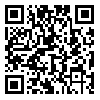Volume 12, Issue 2 (6-2022)
J Health Saf Work 2022, 12(2): 339-351 |
Back to browse issues page
Download citation:
BibTeX | RIS | EndNote | Medlars | ProCite | Reference Manager | RefWorks
Send citation to:



BibTeX | RIS | EndNote | Medlars | ProCite | Reference Manager | RefWorks
Send citation to:
Abbasinia M, Kalatpour O, Motamedzade M, Soltanian A R, Mohammadfam I, Ganjipour M. Development of a human error risk assessment model in high priority emergency situation using TOPSIS, FUZZY-AHP and CREAM method. J Health Saf Work 2022; 12 (2) :339-351
URL: http://jhsw.tums.ac.ir/article-1-6686-en.html
URL: http://jhsw.tums.ac.ir/article-1-6686-en.html
Marzieh Abbasinia1 
 , Omid Kalatpour2
, Omid Kalatpour2 
 , Majid Motamedzade2
, Majid Motamedzade2 
 , Ali Reza Soltanian3
, Ali Reza Soltanian3 
 , Iraj Mohammadfam *
, Iraj Mohammadfam * 
 4, Mohammad Ganjipour5
4, Mohammad Ganjipour5 


 , Omid Kalatpour2
, Omid Kalatpour2 
 , Majid Motamedzade2
, Majid Motamedzade2 
 , Ali Reza Soltanian3
, Ali Reza Soltanian3 
 , Iraj Mohammadfam *
, Iraj Mohammadfam * 
 4, Mohammad Ganjipour5
4, Mohammad Ganjipour5 

1- Center of Excellence for Occupational Health, Occupational Health and Safety Research Center, School of Public Health, Hamadan University of Medical Sciences, Hamadan, Iran
2- Ergonomics Department, Hamadan University of Medical Sciences, Hamadan, Iran
3- Department of Biostatistics, Modeling of Noncommunicable Diseases Research Center, Hamadan University of Medical Sciences, Hamadan, Iran
4- Center of Excellence for Occupational Health, Occupational Health and Safety Research Center, School of Public Health, Hamadan University of Medical Sciences, Hamadan, Iran ,ir.mohammadfam@uswr.ac.ir
5- Shazand Petrochemical Company, Shazand, Iran
2- Ergonomics Department, Hamadan University of Medical Sciences, Hamadan, Iran
3- Department of Biostatistics, Modeling of Noncommunicable Diseases Research Center, Hamadan University of Medical Sciences, Hamadan, Iran
4- Center of Excellence for Occupational Health, Occupational Health and Safety Research Center, School of Public Health, Hamadan University of Medical Sciences, Hamadan, Iran ,
5- Shazand Petrochemical Company, Shazand, Iran
Abstract: (1718 Views)
Introduction: Emergencies are unforeseen and unpredictable situations. In these situations, people’s performance is affected by various factors that cause stress. People’s performance in such situations can also affect human error probability. The purpose of this study was to evaluate human error in emergency situations based on the fuzzy CREAM and Fuzzy Analytical Hierarchy Process (FAHP).
Material and Methods: This descriptive-analytical study was performed in a petrochemical industry in Markazi province in 2019. The FAHP was used to prioritize emergency situations. To evaluate human error in these conditions, the weights of Common Performance Conditions (CPC) was determined using Analytical Hierarchy Process (AHP) method. Human error probability was calculated using a fuzzy CREAM method in the most important emergency situations.
Results: The results of the FAHP showed that “Hydrogen leak from the cylinder joints in the olefin unit” was the most important emergency. The highest relative weight was related to crew collaboration quality (0.06) in the emergency situation.
Conclusion: This method can also be used to identify the important factors in human error occurrence and high weighted CPCs and plan to control them.
Material and Methods: This descriptive-analytical study was performed in a petrochemical industry in Markazi province in 2019. The FAHP was used to prioritize emergency situations. To evaluate human error in these conditions, the weights of Common Performance Conditions (CPC) was determined using Analytical Hierarchy Process (AHP) method. Human error probability was calculated using a fuzzy CREAM method in the most important emergency situations.
Results: The results of the FAHP showed that “Hydrogen leak from the cylinder joints in the olefin unit” was the most important emergency. The highest relative weight was related to crew collaboration quality (0.06) in the emergency situation.
Conclusion: This method can also be used to identify the important factors in human error occurrence and high weighted CPCs and plan to control them.
Type of Study: Research |
Received: 2022/06/26 | Accepted: 2022/06/22 | Published: 2022/06/22
Received: 2022/06/26 | Accepted: 2022/06/22 | Published: 2022/06/22
Send email to the article author
| Rights and permissions | |
 |
This work is licensed under a Creative Commons Attribution-NonCommercial 4.0 International License. |




